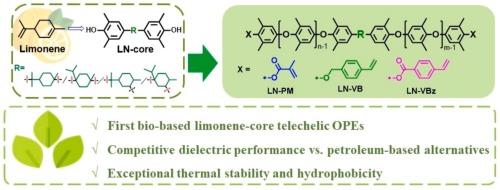柠檬烯基双(2,6-二甲基苯酚)核合成高性能远旋低聚物(2,6-二甲基苯基醚)s
IF 6.3
2区 化学
Q1 POLYMER SCIENCE
引用次数: 0
摘要
随着全球对高频通信材料需求的增长以及环保意识的提高,对可再生资源衍生的低耗散聚合物的需求变得更加迫切。本研究通过Friedel-Crafts烷基化合成了一种新的柠檬烯衍生的双(2,6-二甲基苯酚)(LN-core),并将其作为低聚环氧苯基(LN-OPE)的生物基构建块。所得到的低聚物被不同的可交联端基进一步功能化,得到了一系列远旋OPEs: LN-PM(甲基丙烯酸苯酯)、LN-VB(乙烯基苯醚)和LN-VBz(乙烯基苯甲酸酯)。热固化后,对这些材料的热稳定性、疏水性、吸湿性和介电性能进行了评估,并与商用远旋OPEs (SA9000和OPE-2St)进行了基准测试。值得注意的是,LN-PM热固性材料的玻璃化转变温度(Tg)为228°C, 5%失重温度(Td5%)为478°C,水接触角(WCA)为~ 90.3°,吸水率(Aw)为~ 0.37%,介电常数(Dk)为2.59,耗散系数(Df)为0.0031,与SA9000的性能非常接近。虽然目前的生物基含量有限,但柠檬烯基核心的引入提供了独特的分子结构,避免了沙特基础工业公司和MGC等主要生产商现有的专利限制。这项工作为未来开发具有更高可再生含量的高性能远射光学器件奠定了基础。本文章由计算机程序翻译,如有差异,请以英文原文为准。

Synthesis of high-performance telechelic oligo(2,6-dimethylphenylene ether)s from limonene-based bis(2,6-dimethylphenol) core
As the global demand for high-frequency communication materials grows alongside increasing environmental awareness, the need for low-dissipation polymers derived from renewable resources becomes ever more urgent. In this study, a novel limonene-derived bis(2,6-dimethylphenol) (LN-core) was synthesized via Friedel–Crafts alkylation and employed as a bio-based building block for oligo(phenylene oxide) (LN-OPE). The resulting oligomer was further functionalized with different crosslinkable end groups, yielding a series of telechelic OPEs: LN-PM (phenyl methacrylate), LN-VB (vinylbenzyl ether), and LN-VBz (vinylbenzoate). After thermal curing, these materials were evaluated in terms of thermal stability, hydrophobicity, moisture uptake, and dielectric performance, and benchmarked against commercial telechelic OPEs (SA9000 and OPE-2St). Notably, the LN-PM thermoset achieved a glass transition temperature (Tg) of 228 °C, 5 % weight-loss temperature (Td5%) of 478 °C, a water contact angle (WCA) of ∼90.3°, water absorption (Aw) of ∼0.37 %, a dielectric constant (Dk) of 2.59, and a dissipation factor (Df) of 0.0031, which closely matches the performance of SA9000. While the current bio-based content is modest, the introduction of a limonene-based core offers a unique molecular structure that avoids existing patent restrictions from major producers such as SABIC and MGC. This work sets the stage for future development of high-performance telechelic OPEs with significantly higher renewable content.
求助全文
通过发布文献求助,成功后即可免费获取论文全文。
去求助
来源期刊

European Polymer Journal
化学-高分子科学
CiteScore
9.90
自引率
10.00%
发文量
691
审稿时长
23 days
期刊介绍:
European Polymer Journal is dedicated to publishing work on fundamental and applied polymer chemistry and macromolecular materials. The journal covers all aspects of polymer synthesis, including polymerization mechanisms and chemical functional transformations, with a focus on novel polymers and the relationships between molecular structure and polymer properties. In addition, we welcome submissions on bio-based or renewable polymers, stimuli-responsive systems and polymer bio-hybrids. European Polymer Journal also publishes research on the biomedical application of polymers, including drug delivery and regenerative medicine. The main scope is covered but not limited to the following core research areas:
Polymer synthesis and functionalization
• Novel synthetic routes for polymerization, functional modification, controlled/living polymerization and precision polymers.
Stimuli-responsive polymers
• Including shape memory and self-healing polymers.
Supramolecular polymers and self-assembly
• Molecular recognition and higher order polymer structures.
Renewable and sustainable polymers
• Bio-based, biodegradable and anti-microbial polymers and polymeric bio-nanocomposites.
Polymers at interfaces and surfaces
• Chemistry and engineering of surfaces with biological relevance, including patterning, antifouling polymers and polymers for membrane applications.
Biomedical applications and nanomedicine
• Polymers for regenerative medicine, drug delivery molecular release and gene therapy
The scope of European Polymer Journal no longer includes Polymer Physics.
 求助内容:
求助内容: 应助结果提醒方式:
应助结果提醒方式:


